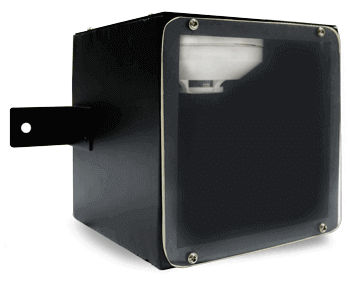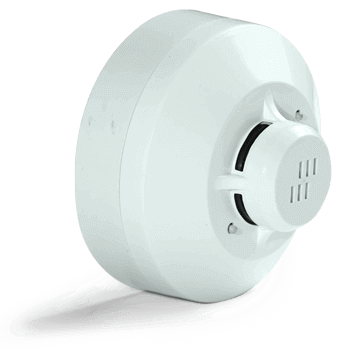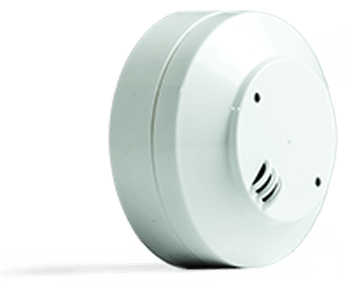About Smoke Detector
- Addressable smoke detectors detect smoke particles and accurately measure their density.
- They offer additional features, such as the ability to set user-defined pre-alarms.
- During the pre-alarm stage, the control panel activates an internal alarm sounder, providing an early warning limited to support staff.
- When the smoke density surpasses the main alarm threshold, the control panel can activate external alarm devices like sirens and strobe lights, indicating a more significant fire event.
- Addressable smoke detectors function digitally, allowing communication between individual detectors and the control panel.
- This communication capability enables sensitivity adjustments, control functions, and the assignment and modification of unique identification codes.
- The flexibility and customization options of addressable detectors make them well-suited for diverse building layouts and specific requirements.
- When smoke detector exceeds tolerances level of contamination. It provides contaminated alarm .
Common Complaints From Smoke Detector And Fire Alarm Users Include:
- Frequent false alarms due to lack of maintenance and dust contamination.
- Delayed activation of fire alarms, allowing rooms to fill with dense smoke before the alarm response.
- Alarms triggered by minor incidents, causing unnecessary panic and confusion.
- Non-functional fire alarm systems during unexpected inspections, leading to licensing issues.
To address these concerns, Airlight has developed solutions. Airlight’s smoke detector is specifically designed to discriminate between dust contamination and smoke, reducing false alarms. They have also developed ultra-sensitive smoke detectors that can detect fires in their early stages, minimizing response delays. Airlight provides calibration services to ensure accurate performance.
Additionally, Airlight offers a mobile app that enables users, engineers, and AMC providers to control and monitor the fire alarm system remotely, providing convenience and enhanced functionality. These advancements aim to improve the reliability, effectiveness, and ease of use of smoke detectors and fire alarm systems.
Thermal detection is a crucial element of fire alarm systems. Heat detectors perform continuous monitoring of the temperature in their surroundings and activate when abnormal or rapid temperature increases are detected, indicating a potential fire. To cater to different needs, we offer a range of heat detectors including conventional, addressable, and wireless models.
Conventional smoke detectors function by employing a fixed threshold level that is pre-set during the manufacturing process. These detectors generate a binary output signal, indicating an ON or OFF state for the alarm. Under normal conditions, conventional smoke detectors consume minimal current, referred to as quiescent current. However, when the detectors detect an alarm condition, they draw a higher current known as alarm current. The change in current is monitored by a conventional fire panel, which interprets the signal and signals the potential presence of a fire.
Addressable smoke detectors operate by detecting smoke particles and measuring their density. Similarly to conventional detectors, they wait until the smoke density surpasses a pre-set alarm threshold. When this threshold is exceeded, addressable smoke detectors initiate an alarm signal. However, what sets them apart are their additional features and capabilities. Addressable detectors allow for the setting of preliminary stage alarms, known as pre-alarms, based on user preferences. During the pre-alarm stage, only the alarm sounder within the control panel is activated, providing an early warning. As the smoke density further increases and crosses the main alarm threshold, external alarm devices such as sirens and strobe lights are triggered, indicating a more significant fire event. Furthermore, addressable smoke detectors function as digital devices, enabling communication between individual detectors and the control panel. This communication capability allows for various settings and functionalities. It includes sensitivity adjustments, control functions, and the ability to assign and modify unique identification (ID) codes for easy identification and management. The flexibility and customization options offered by addressable detectors make them well-suited for diverse building layouts and specific requirements.
Airlight smoke detectors have a notable highlight: they feature an ultra-sensitive smoke sensor that enables the detection of smoke at a very early stage of a fire. This heightened sensitivity, developed by Airlight, ensures that potential fire incidents are detected swiftly, enhancing overall safety. Additionally, Airlight’s range of addressable detectors offers the capability to continuously capture real-time smoke density levels and relay this information to the control panel. The real-time data regarding smoke density and its specific location within the building is displayed on the control panel. This valuable information enables support staff to promptly assess the situation and take appropriate action. Airlight’s provision of real-time smoke density information enhances situational awareness and facilitates effective decision-making for mitigating fire risks.
Life of smoke detector is too short, it may give correct measurements hardly for two years. Smoke detector works on photo electric principle. Smoke chamber LED and its allied circuit gets deteriorate due to aging, hence the sensitivity of smoke detector losses it’s sensitivity. Out of range sensitivity detector may not deliver its function. Hence the smoke detector required periodical calibration. ( refer IS 2189 )
When selecting a smoke sensor, it’s important to consider its efficiency in detecting smoke. The efficiency is determined by the sensor’s measurement scale or sensitivity.
Smoke sensors have different measurement scales, typically starting from 0.01%. Some sensors are capable of detecting smoke at a low density of 0.05 obscuration per foot, while others require a higher density of 2% to activate.
The efficiency of a smoke sensor directly affects its response time. Sensors with higher efficiency can quickly detect and react to smoke, resulting in shorter response times. On the other hand, sensors with lower efficiency may take longer to detect smoke and trigger an alarm.
Therefore, when choosing a smoke sensor, it is advisable to select one with a higher efficiency and a lower measurement threshold for smoke detection. This ensures faster response times and increased effectiveness in alerting to potential fire hazards.
- Light Source: A photoelectric smoke sensor consists of LED (Light Emitting Diode) as a light source and a photodetector.
- Chamber Design: The sensor chamber is designed to allow ambient air to flow freely while preventing external light from entering the sensing chamber.
- Scattering of Light: In normal conditions, the emitted light from the LED does not directly reach the photodetector. However, when smoke particles enter the chamber, they scatter the light, causing some of it to be redirected towards the photodetector.
- Detection Process: The photodetector senses the scattered light, and when a certain threshold is reached, it triggers the smoke alarm.
Smoke sensor chamber shall be maintained dark for effective smoke detection. The smoke chamber is vulnerable to get dust contamination due to pollution . Contaminated sensors tend to provide false alarm signal. Control panel has provision to check level of contamination, user can periodically check the level of contamination, if any contaminated sensors are found those sensors shall be removed for cleaning and other sensors can be kept undisturbed. If any sensors are found more contaminated, control panel will raise an contamination alarm to alert user.
A smoke sensor is an instrument used to measure smoke density. It operates based on the photoelectric principle, utilizing an LED to illuminate the smoke chamber. However, over time, the LED’s illumination capability deteriorates. This phenomenon is similar to what we experience with LED lamps at home, where their brightness decreases after a few months, requiring replacement. The same applies to the LED in the sensor’s chamber and its associated circuitry. As they age, the sensitivity of the smoke detector gradually diminishes from its original level.
To restore the smoke sensor to its original sensitivity, the solution lies in periodic calibration. This calibration process is typically carried out by the original equipment manufacturer (OEM). During calibration, the OEM performs sensitivity checks using a master sensor. If the sensor being calibrated falls outside the acceptable sensitivity range, the OEM will replace the LED and perform the necessary adjustments to bring the sensor back to its original sensitivity level.
Calibration of smoke detectors can only be carried out by the original equipment manufacturer (OEM). This is because each OEM has engineered their smoke detectors using their unique techniques, making it a technology and trade secret. As a result, only the OEM has the necessary knowledge and expertise to accurately calibrate their smoke detectors.
Yes, periodic calibration is mandatory according to the National Building Code, specifically stated in IS 2189. When applying for the initial building license and during license renewal, calibration certificates must be provided. It is the responsibility of the builder, building owner, system installer, annual maintenance contract (AMC) contractor, fire authorities, and third-party auditors to ensure compliance with this requirement and verify the calibration status.
To ensure calibration service support from the original equipment manufacturer (OEM), you should negotiate with suppliers regarding warranty and guarantee terms for the proposed smoke detector. Request assurance for the expected lifespan of the smoke detector while maintaining its original sensitivity, as well as information on the acceptable deviation level over one or two years. The OEM should provide free calibration services or charge a nominal fee for them. Additionally, any sensors that fall out of sensitivity range should be rectified or replaced by the OEM at no cost. This agreement should be made in writing to protect the investment made in the automatic fire alarm system, with a calibration service support guarantee of at least five years.
Even though the smoke sensor may appear to be functioning correctly during periodic checks with agarbathi (incense stick), it is not a professional or reliable method for validating its functionality. Over time, smoke detectors can deteriorate and lose their effectiveness. Relying solely on the perception of safety provided by an aged smoke sensor can be misleading. It is the responsibility of fire authorities, auditors, building owners, AMC contractors, and other stakeholders to ensure that the fire detection system is in proper working condition. Neglecting calibration and relying on outdated or potentially faulty smoke sensors can have serious consequences in the event of a fire incident, as it may impact the liability of responsible authorities and insurance coverage for potential losses.
Certification agencies such as UL (Underwriters Laboratories), FM (Factory Mutual), and others serve as American government-accredited laboratories that offer services for conducting environmental-type tests to validate the functionality of smoke detectors. These tests are designed to meet the standards prescribed in American standards, such as ASTM (American Society for Testing and Materials). If a smoke detector successfully passes these tests, the certification agencies can provide certification.
However, it’s important to note that these certifications do not necessarily guarantee the quality of the smoke detectors. Moreover, in India, these certifications are not mandatory and may not be beneficial or relevant for the original equipment manufacturer (OEM) or the buyer.
Airlight’s Approach
When it comes to talkback, PA (Public Address), and fire alarm systems, Airlight proposes the use of 2 core cables, whereas others commonly use multi-core cables. But why is cable integrity important, and what does it entail?
Cables play a crucial role in powering and signaling devices in fire detection and notification systems. In the event of a fire, the fire system must sustain and fulfill its requirements. Therefore, it is essential for the entire fire system cable to have mechanical protection and fire survival capabilities. Additionally, as per fire safety standards, the entire cable used in a system should be electrically supervised against open and short circuits.
The decision to use 2 core cables by Airlight takes into account several factors. First, it considers the cost factor of cable procurement and laying. Additionally, incorporating electrical supervision circuits and equipment adds complexity and cost to the design.
Recognizing these needs, Airlight has made significant technological advancements to comply with the requirements of cable integrity in fire detection and alarm systems. These improvements ensure that Airlight’s solutions not only meet fire safety standards but also offer cost-effective and reliable performance.
In summary, Airlight’s approach to cable integrity takes into account the importance of mechanical protection, fire survival, and electrical supervision. By addressing these factors, Airlight delivers innovative solutions that meet the needs of fire detection and alarm systems while offering cost-effectiveness and reliability
1. Spot Type Smoke Detector:
– Detection Method: Spot type smoke detect smoke particles in a specific spot or area where the device is installed. They trigger an alarm when smoke is detected in their immediate vicinity.
– Application: widely used for all multi storied and many applications.
2. Aspiration Type Smoke Detector:
– Detection Method: Aspiration type smoke detectors, also known as air-sampling smoke detectors, continuously draw in air from the protected area using a network of pipes and fans. They analyze the air for smoke particles, providing early detection of fires.
– Application: Ideal for environments where early detection is crucial, like data centers, museums, or areas with high ceilings. They are especially useful in spaces where rapid response is necessary and where spot detectors might be challenging to install or maintain.
3. Beam Type Smoke Detector:
– Detection Method: Beam type smoke detectors use a transmitter and receiver to send a beam of light across a space. When smoke particles interrupt the beam, the detector triggers an alarm. They are used to cover larger areas.
– Application: Suitable for open spaces, such as warehouses, auditoriums, or atriums, where installing individual spot detectors might be impractical due to the area’s size. Beam detectors can cover long distances and are effective for wide-area coverage.
In summary, spot detectors focus on specific spots, aspiration detectors continuously sample air for early detection, and beam detectors cover large open areas by using beams of light to detect smoke particles interrupting the signal. Each type is suited for different applications based on the specific requirements of the environment.
1. Standalone Smoke Detector:
– Functionality: Standalone smoke detectors operate independently and are not connected to a broader alarm system. They function autonomously and sound an alarm when they detect smoke.
– Installation: Easy to install, they are suitable for smaller spaces and homes where a comprehensive alarm system is not necessary.
2. Conventional Smoke Detector:
– Functionality: Conventional smoke detectors are connected to a central control panel. They are divided into zones, and when smoke is detected, the specific zone is indicated on the control panel. However, these detectors do not provide specific information about the location of the alarm within the zone.
– Installation: Commonly used in commercial buildings, they allow for basic zoning but lack detailed information about the exact location of the alarm.
3. Addressable Smoke Detector:
– Functionality: Addressable smoke detectors are also connected to a central control panel but provide specific information about the exact location of the alarm within the building. Each detector has a unique address, allowing the control panel to pinpoint the source of the alarm.
– Installation: Used in larger and more complex buildings, such as hotels and hospitals, where precise identification of the alarm location is crucial for a quick response.
4. Wireless Smoke Detector:
– Functionality: Wireless smoke detectors operate without the need for physical wiring between the detectors and the control panel. They communicate wirelessly, making installation easier and more flexible.
– Installation: Ideal for retrofitting existing buildings where running wires is challenging. They are also suitable for temporary installations or places where wiring is not practical.
In summary, standalone detectors work independently, conventional detectors are connected to a central panel with basic zoning, addressable detectors provide precise location information, and wireless detectors communicate without physical wiring, offering flexibility in installation. The choice depends on the specific requirements and complexity of the building or space.





